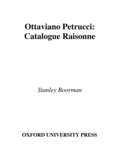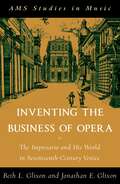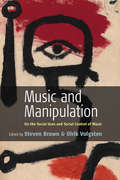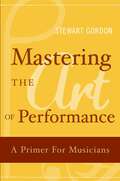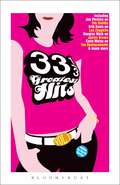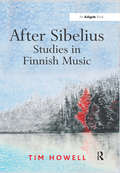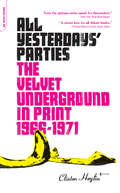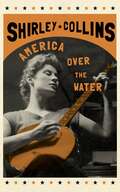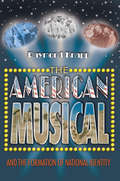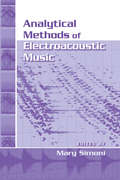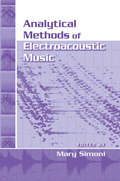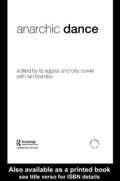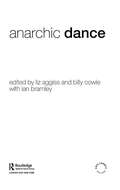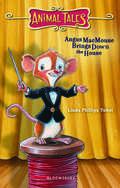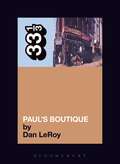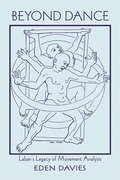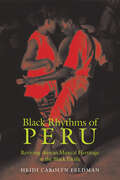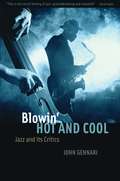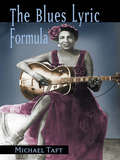- Table View
- List View
Ottaviano Petrucci: A Catalogue Raisonné
by Stanley BoormanThe innovative work in design, typography, and content of music printer and publisher Ottaviano Petrucci (1446-1539) became the standard by which all following printers measured themselves. He created the defining moment when Italy took the lead in book printing in the Renaissance. This book is a bibliographic study of the output of the Petrucci presses, laying emphasis on the professional career of Petrucci. It includes a detailed study of technique and house-style, examining the market forces that drove Petrucci's publishing decisions, and provides a detailed catalogue of editions and copies. Stanley Boorman has made a study of the output of Petrucci's presses for 25 years. This long-awaited contribution to the field of bibliography will have an audience both in music and in rare book bibliography.
Inventing the Business of Opera: The Impresario and His World in Seventeenth Century Venice (AMS Studies in Music)
by Beth Glixon Jonathan GlixonIn mid seventeenth-century Venice, opera first emerged from courts and private drawing rooms to become a form of public entertainment. Early commercial operas were elaborate spectacles, featuring ornate costumes and set design along with dancing and music. As ambitious works of theater, these productions required not only significant financial backing, but also strong managers to oversee several months of rehearsals and performances. These impresarios were responsible for every facet of production from contracting the cast to balancing the books at season's end. The systems they created still survive, in part, today. Inventing the Business of Opera explores public opera in its infancy, from 1637 to 1677, when theater owners and impresarios established Venice as the operatic capital of Europe. Drawing on extensive new documentation, the book studies all of the components necessary to opera production, from the financial backing of various populations of Venice, to the commissioning and creation of the libretto and the score; the recruitment and employment of singers, dancers, and instrumentalists; the production of the scenery and the costumes, and, the nature of the audience; and, finally, the issue of patronage. Throughout the book, the problems faced by impresarios come into new focus. The authors chronicle the progress of Marco Faustini, the impresario most well known today, who made his way from one of Venice's smallest theaters to one of the largest. His companies provide the most personal view of an impresario and his partners, who ranged from Venetian nobles to artisans. Throughout the book, Venice emerges as a city that prized novelty over economy, with new repertory, scenery, costumes, and expensive singers the rule rather than the exception. The authors examine the challenges faced by four separate Venetian theaters during the seventeenth century: San Cassiano, the first opera theater, the Novissimo, the small Sant'Aponal, and San Luca, established in 1660. Only two of them would survive past the 1650s. Through close examination of an extraordinary cache of documents--including personal papers, account books, and correspondence -- Beth and Jonathan Glixon provide a comprehensive view of opera production in mid-seventeenth century Venice. For the first time in a study of opera, an emphasis is placed on the physical production -- the scenery, costumes, and stage machinery -- that tied these opera productions to the social and economic life of the city. This original and meticulously researched study will be of strong interest to all students of opera and its history.
Music and Manipulation: On the Social Uses and Social Control of Music
by Steven Brown Ulrik VolgstenSince the beginning of human civilization, music has been used as a device to control social behavior, where it has operated as much to promote solidarity within groups as hostility between competing groups. Music is an emotive manipulator that influences attitude, motivation and behavior at many levels and in many contexts. This volume is the first to address the social ramifications of music’s behaviorally manipulative effects, its morally questionable uses and control mechanisms, and its economic and artistic regulation through commercialization, thus highlighting not only music’s diverse uses at the social level but also the ever-fragile relationship between aesthetics and morality.
Mastering the Art of Performance: A Primer for Musicians
by Stewart GordonIn Mastering the Art of Performance: A Primer for Musicians, Stewart Gordon offers seasoned advice to musicians intent on meeting the challenges of performance. Through real-life examples and pre-performance exercises, this accessible manual gives musicians and other performers practical insights into every aspect of performance. While other books merely identify and describe the problems associated with performance, this book offers detailed suggestions for solving them. First, Gordon tackles the critical planning and preparatory stages, helping performers to evaluate their strengths and weaknesses. The book's easy-to-follow exercises address the self-doubt and anxiety many musicians contend with, helping them to analyze why they perform, set goals and assess the level of energy needed to achieve them, and develop a performance philosophy. The book also offers techniques that will help musicians deal with some of the classic pitfalls of performance preparation, including repetition and drill, changing bad habits, and developing memory. For the performance itself, Gordon's insights help musicians with pacing and managing stage fright. For the aftermath, Gordon arms performers with strategies for dealing with criticism and conducting a constructive self-evaluation, equipping them to face the challenges of a lifetime of performances, including career plateaus and burnout. Gordon draws from more than forty years of experience in front of audiences to offer readers invaluable tips and personal reflections. While aimed primarily at musicians, the book will be useful to anyone facing the pressures of performance, such as actors, dancers, and even public speakers.
33 1/3 Greatest Hits, Volume 1 (33 1/3 #Volume 1)
by David BarkerThe writings in this book are extracted from volumes 1 through 20 of our 33 1/3 series - short books about individual albums. In here you'll find a wide variety of authors, albums, and approaches to writing about those albums. So sit back, put on your headphones, cue up your favourite songs, and let our writers transport you to a time when: Dusty Springfield headed south to Memphis to record a pop/soul classic; The Kinks almost fell to pieces, and managed to make their best album while doing so; Joy Division and their mad, brilliant producer created a debut record that still sounds painfully hip today; James Brown mesmerized a sell-out crowd at the Apollo, in the midst of the Cuban Missile Crisis; The Rolling Stones shacked up in the South of France and emerged with one of the best double-albums ever; The Ramones distilled punk rock into its purest, most enduring essence... 33 1/3 Greatest Hits, Volume 1: it's like a compilation album, without the filler.
After Sibelius: Studies in Finnish Music
by Tim HowellDuring the last twenty years, the rest of the world has come to focus on the music of Finland. The seemingly disproportionate creative energy from this small country defies prevalent trends in the production of classical music. Tim Howell provides an engaging investigation into Finnish music and combines elements of composer biography and detailed analysis within the broader context of cultural and national identity. The book consists of a collection of eight individual composer studies that investigate the historical position and compositional characteristics of a representative selection of leading figures, ranging from the beginning of the twentieth century to the present day. These potentially self-contained studies subscribe to a larger picture, which explains the Sibelian legacy, the effect of this considerable influence on subsequent generations and its lasting consequences: an internationally acclaimed school of contemporary music. Outlining a particular perspective on modernism, Howell provides a careful balance between biographical and analytical concerns to allow the work to be accessible to the non-specialist. Each composer study offers a sense of overview followed by progressively more detail. Close readings of selected orchestral works provide a focus, while the structure of each analysis accommodates the different levels of engagement expected by a wide readership. The composers under consideration are Aarre Merikanto, Erik Bergman, Joonas Kokkonen, Einojuhani Rautavaara, Aulis Sallinen, Paavo Heininen, Kaija Saariaho and Magnus Lindberg. The concluding discussion of issues of national distinctiveness and the whole phenomenon of why such a small nation is compositionally so active, is of wide-ranging significance. Drawing together various strands to emerge from these individual personalities, Howell explores the Finnish attitude to new music, in both its composition and reception, uncovering an enlightened view of the value of creativity from which
After Sibelius: Studies in Finnish Music
by Tim HowellDuring the last twenty years, the rest of the world has come to focus on the music of Finland. The seemingly disproportionate creative energy from this small country defies prevalent trends in the production of classical music. Tim Howell provides an engaging investigation into Finnish music and combines elements of composer biography and detailed analysis within the broader context of cultural and national identity. The book consists of a collection of eight individual composer studies that investigate the historical position and compositional characteristics of a representative selection of leading figures, ranging from the beginning of the twentieth century to the present day. These potentially self-contained studies subscribe to a larger picture, which explains the Sibelian legacy, the effect of this considerable influence on subsequent generations and its lasting consequences: an internationally acclaimed school of contemporary music. Outlining a particular perspective on modernism, Howell provides a careful balance between biographical and analytical concerns to allow the work to be accessible to the non-specialist. Each composer study offers a sense of overview followed by progressively more detail. Close readings of selected orchestral works provide a focus, while the structure of each analysis accommodates the different levels of engagement expected by a wide readership. The composers under consideration are Aarre Merikanto, Erik Bergman, Joonas Kokkonen, Einojuhani Rautavaara, Aulis Sallinen, Paavo Heininen, Kaija Saariaho and Magnus Lindberg. The concluding discussion of issues of national distinctiveness and the whole phenomenon of why such a small nation is compositionally so active, is of wide-ranging significance. Drawing together various strands to emerge from these individual personalities, Howell explores the Finnish attitude to new music, in both its composition and reception, uncovering an enlightened view of the value of creativity from which
All Yesterdays' Parties: The Velvet Underground in Print, 1966-1971
by Clinton HeylinThe Velvet Underground, among the most influential bands of all time, are credited with creating a streetwise, pre-punk sensibility that has become inseparable from the popular image of downtown New York. "Discovered" by Andy Warhol in 1966, the VU - with their original line-up of Lou Reed, John Cale, Sterling Morrison, and Mo Tucker - would soon become the house band of the avantgarde, composing songs simultaneously furious in their abrasiveness and beautiful in their pathos, standing in striking contrast to the prevailing flower power of the era. All Yesterdays' Parties gathers for the first time almost all of the published writings contemporary with the band's existence-from sources as mainstream as the New York Times to vanished voices of the counterculture like Oz, Fusion, and Crawdaddy! The book is a revealing snapshot of an era by trailblazing rock writers such as Lester Bangs, Robert Greenfield, and Paul Williams. With photographs, posters, and other visual evocations of the period throughout, All Yesterdays' Parties is an invaluable resource, a trove of lore for anyone interested in the VU, their roots, and legacy.
America Over the Water
by Shirley Collins'Shirley is a time traveller, a conduit for essential human aches, one of the greatest artists who ever lived' Stewart Lee'Without doubt one of England's greatest cultural treasures' Billy BraggIn America Over the Water, celebrated English folksinger Shirley Collins offers an affecting account of her year-long stint as assistant to legendary musical historian and folklorist Alan Lomax. Together, they travelled to Virginia, Kentucky, Alabama, Mississippi, Arkansas and Georgia, discovering Mississippi Fred McDowell and many others, in their tireless work to uncover the traditional music of America's heartland. Blending the personal story of Shirley Collins' relationship with Lomax and offering a unique first-hand account of a country on the brink of the civil rights era, America Over the Water cuts right to the heart of the blues in a fascinating account of Collins' and Lomax's ground-breaking journey across the southern states of the USA to record the music that started it all. Originally published over fifteen years ago, this definitive edition includes a new introduction by Shirley Collins.
The American Musical and the Formation of National Identity
by Raymond KnappThe American musical has achieved and maintained relevance to more people in America than any other performance-based art. This thoughtful history of the genre, intended for readers of all stripes, offers probing discussions of how American musicals, especially through their musical numbers, advance themes related to American national identity. Written by a musicologist and supported by a wealth of illustrative audio examples (on the book's website), the book examines key historical antecedents to the musical, including the Gilbert and Sullivan operetta, nineteenth and early twentieth-century American burlesque and vaudeville, Tin Pan Alley, and other song types. It then proceeds thematically, focusing primarily on fifteen mainstream shows from the twentieth century, with discussions of such notable productions as Show Boat (1927), Porgy and Bess (1935), Oklahoma! (1943), West Side Story (1957), Hair (1967), Pacific Overtures (1976), and Assassins (1991). The shows are grouped according to their treatment of themes that include defining America, mythologies, counter-mythologies, race and ethnicity, dealing with World War II, and exoticism. Each chapter concludes with a brief consideration of available scholarship on related subjects; an extensive appendix provides information on each show discussed, including plot summaries and song lists, and a listing of important films, videos, audio recordings, published scores, and libretti associated with each musical.
Analytical Methods of Electroacoustic Music
by Mary SimoniContaining extensive artwork serving as demonstration, as well as a DVD with sound and video clips, this collection of essays on electroacoustic music explores the creative possibilities to be found in various forms of musical analysis. Taking pitch, duration, intensity, and timbre as the four basic elements of music, the authors discuss electroacoustic works and examine: * the applications of neumes* contemporary staff notation* sound orchestra and score files* time-domain representations* spectrograms. Taking into consideration both the positive aspects (preservation of the abstract) and negative aspects (creative limitation) of these analytical methods, the authors have created a useful resource for students of electroacoustic music.
Analytical Methods of Electroacoustic Music
by Mary SimoniContaining extensive artwork serving as demonstration, as well as a DVD with sound and video clips, this collection of essays on electroacoustic music explores the creative possibilities to be found in various forms of musical analysis. Taking pitch, duration, intensity, and timbre as the four basic elements of music, the authors discuss electroacoustic works and examine: * the applications of neumes* contemporary staff notation* sound orchestra and score files* time-domain representations* spectrograms. Taking into consideration both the positive aspects (preservation of the abstract) and negative aspects (creative limitation) of these analytical methods, the authors have created a useful resource for students of electroacoustic music.
Anarchic Dance
by Liz Aggiss Billy Cowie Ian BramleyLiz Aggiss and Billy Cowie, known collectively as Divas Dance Theatre, are renowned for their highly visual, interdisciplinary brand of dance performance that incorporates elements of theatre, film, opera, poetry and vaudevillian humour. Anarchic Dance, consisting of a book and DVD-Rom, is a visual and textual record of their boundary-shattering performance work. The DVD-Rom features extracts from Aggiss and Cowie's work, including the highly-acclaimed dance film Motion Control (premiered on BBC2 in 2002), rare video footage of their punk-comic live performances as The Wild Wigglers and reconstructions of Aggiss's solo performance in Grotesque Dancer. These films are cross-referenced in the book, allowing readers to match performance and commentary as Aggiss and Cowie invite a broad range of writers to examine their live performance and dance screen practice through analysis, theory, discussion and personal response. Extensively illustrated with black and white and colour photographs Anarchic Dance, provides a comprehensive investigation into Cowie and Aggiss’s collaborative partnership and demonstrates a range of exciting approaches through which dance performance can be engaged critically.
Anarchic Dance
by Liz Aggiss Billy CowieLiz Aggiss and Billy Cowie, known collectively as Divas Dance Theatre, are renowned for their highly visual, interdisciplinary brand of dance performance that incorporates elements of theatre, film, opera, poetry and vaudevillian humour. Anarchic Dance, consisting of a book and DVD-Rom, is a visual and textual record of their boundary-shattering performance work. The DVD-Rom features extracts from Aggiss and Cowie's work, including the highly-acclaimed dance film Motion Control (premiered on BBC2 in 2002), rare video footage of their punk-comic live performances as The Wild Wigglers and reconstructions of Aggiss's solo performance in Grotesque Dancer. These films are cross-referenced in the book, allowing readers to match performance and commentary as Aggiss and Cowie invite a broad range of writers to examine their live performance and dance screen practice through analysis, theory, discussion and personal response. Extensively illustrated with black and white and colour photographs Anarchic Dance, provides a comprehensive investigation into Cowie and Aggiss’s collaborative partnership and demonstrates a range of exciting approaches through which dance performance can be engaged critically.
Angus MacMouse Brings Down the House (Animal Tales)
by Linda Phillips TeitelWhen a poor street mouse named Angus accidentally wanders onto the stage of the opera, he scares the soprano so much that she sings a record-breaking high note. Word gets out, and soon the soprano, Minnie McGraw, becomes world famous, and goes on tour with Angus as her secret. But things go wrong when Angus becomes famous in his own right and Minnie grows jealous. Minnie and Carlo, the scheming tenor, come up with a plan to mousenap Angus! Trapped in a cage backstage, will Angus be able to escape in time to save the opera company from ruin?
Auftakte – Nachspiele: Studien zur musikalischen Interpretation
by Peter GülkeMusik zwischen Inspiration und Reflexion. Gülkes Schriften geben Auskunft u.a. zu historischer Aufführungspraxis, zur Entwicklung des Orchesters, zur Musikedition, zur musikalischer Interpretation einzelner Werke und zum Wandel des Dirigentenbildes. Porträtiert werden zudem große Dirigenten, darunter Bülow, Mahler, Toscanini, Furtwängler, Wand, Kleiber und von Karajan. Gülke verbindet den persönlichen Blick mit fundiertem Wissen.
The Beastie Boys' Paul's Boutique (33 1/3 #Vol. 33)
by Dan LeRoyDerided as one-hit wonders, estranged from their original producer and record label, and in self-imposed exile in Los Angeles, the Beastie Boys were written off by most observers before even beginning to record their second album - an embarrassing commercial flop that should have ruined the group's career. But not only did "Paul's Boutique" eventually transformed the Beasties from a fratboy novelty to hiphop giants, its sample-happy, retro aesthetic changed popular culture forever.
Beyond Dance: Laban's Legacy of Movement Analysis
by Eden DaviesBeyond Dance: Laban's Legacy of Movement Analysis offers students of dance and movement a brief introduction to the life and work of Rudolf Laban, and how this work has been extended into the fields of movement therapy, communications, early childhood development, and other fields. While many dance students know of Laban and his work as it applies to their field, few know the full story of how this technique has developed and grown. For many who enter into the fields of dance movement therapy, performance, and communications, there are valuable lessons to be learned from Laban and his follower's works. Beyond Dance offers a concise introduction to this world. Refreshingly free of jargon and easy to understand, the work offers dance students – and others interested in human movement – a full picture of the many possibilities inherent in Laban's theories. For many who will pursue careers 'beyond dance', this work will be a useful guidebook into related areas. This will be ideally suited to students of Laban movement theory in dance and movement therapy, and will be used in advanced courses in these areas as useful, brief introduction to the field.
Beyond Dance: Laban's Legacy of Movement Analysis
by Eden DaviesBeyond Dance: Laban's Legacy of Movement Analysis offers students of dance and movement a brief introduction to the life and work of Rudolf Laban, and how this work has been extended into the fields of movement therapy, communications, early childhood development, and other fields. While many dance students know of Laban and his work as it applies to their field, few know the full story of how this technique has developed and grown. For many who enter into the fields of dance movement therapy, performance, and communications, there are valuable lessons to be learned from Laban and his follower's works. Beyond Dance offers a concise introduction to this world. Refreshingly free of jargon and easy to understand, the work offers dance students – and others interested in human movement – a full picture of the many possibilities inherent in Laban's theories. For many who will pursue careers 'beyond dance', this work will be a useful guidebook into related areas. This will be ideally suited to students of Laban movement theory in dance and movement therapy, and will be used in advanced courses in these areas as useful, brief introduction to the field.
Black Rhythms of Peru: Reviving African Musical Heritage in the Black Pacific (Music / Culture)
by Heidi FeldmanWinner of the IASPM's Woody Guthrie Award (2007)In the late 1950s to 1970s, an Afro-Peruvian revival brought the forgotten music and dances of Peru's African musical heritage to Lima's theatrical stages. The revival conjured newly imagined links to the past in order to celebrate—and to some extent recreate—Black culture in Peru. In this groundbreaking study of the Afro-Peruvian revival and its aftermath, Heidi Carolyn Feldman reveals how Afro-Peruvian artists remapped blackness from the perspective of the "Black Pacific," a marginalized group of African diasporic communities along Latin America's Pacific coast. Feldman's "ethnography of remembering" traces the memory projects of charismatic Afro-Peruvian revival artists and companies, including José Durand, Nicomedes and Victoria Santa Cruz, and Perú Negro, culminating with Susana Baca's entry onto the global world music stage in the 1990s. Readers will learn how Afro-Peruvian music and dance genres, although recreated in the revival to symbolize the ancient and forgotten past, express competing modern beliefs regarding what constitutes "Black Rhythms of Peru."
Blowin' Hot and Cool: Jazz and Its Critics
by John GennariIn the illustrious and richly documented history of American jazz, no figure has been more controversial than the jazz critic. Jazz critics can be revered or reviled—often both—but they should not be ignored. And while the tradition of jazz has been covered from seemingly every angle, nobody has ever turned the pen back on itself to chronicle the many writers who have helped define how we listen to and how we understand jazz. That is, of course, until now. In Blowin’ Hot and Cool, John Gennari provides a definitive history of jazz criticism from the 1920s to the present. The music itself is prominent in his account, as are the musicians—from Louis Armstrong and Duke Ellington to Charlie Parker, John Coltrane, Roscoe Mitchell, and beyond. But the work takes its shape from fascinating stories of the tradition’s key critics—Leonard Feather, Martin Williams, Whitney Balliett, Dan Morgenstern, Gary Giddins, and Stanley Crouch, among many others. Gennari is the first to show the many ways these critics have mediated the relationship between the musicians and the audience—not merely as writers, but in many cases as producers, broadcasters, concert organizers, and public intellectuals as well. For Gennari, the jazz tradition is not so much a collection of recordings and performances as it is a rancorous debate—the dissonant noise clamoring in response to the sounds of jazz. Against the backdrop of racial strife, class and gender issues, war, and protest that has defined the past seventy-five years in America, Blowin’ Hot and Cool brings to the fore jazz’s most vital critics and the role they have played not only in defining the history of jazz but also in shaping jazz’s significance in American culture and life.
Blowin' Hot and Cool: Jazz and Its Critics
by John GennariIn the illustrious and richly documented history of American jazz, no figure has been more controversial than the jazz critic. Jazz critics can be revered or reviled—often both—but they should not be ignored. And while the tradition of jazz has been covered from seemingly every angle, nobody has ever turned the pen back on itself to chronicle the many writers who have helped define how we listen to and how we understand jazz. That is, of course, until now. In Blowin’ Hot and Cool, John Gennari provides a definitive history of jazz criticism from the 1920s to the present. The music itself is prominent in his account, as are the musicians—from Louis Armstrong and Duke Ellington to Charlie Parker, John Coltrane, Roscoe Mitchell, and beyond. But the work takes its shape from fascinating stories of the tradition’s key critics—Leonard Feather, Martin Williams, Whitney Balliett, Dan Morgenstern, Gary Giddins, and Stanley Crouch, among many others. Gennari is the first to show the many ways these critics have mediated the relationship between the musicians and the audience—not merely as writers, but in many cases as producers, broadcasters, concert organizers, and public intellectuals as well. For Gennari, the jazz tradition is not so much a collection of recordings and performances as it is a rancorous debate—the dissonant noise clamoring in response to the sounds of jazz. Against the backdrop of racial strife, class and gender issues, war, and protest that has defined the past seventy-five years in America, Blowin’ Hot and Cool brings to the fore jazz’s most vital critics and the role they have played not only in defining the history of jazz but also in shaping jazz’s significance in American culture and life.
Blowin' Hot and Cool: Jazz and Its Critics
by John GennariIn the illustrious and richly documented history of American jazz, no figure has been more controversial than the jazz critic. Jazz critics can be revered or reviled—often both—but they should not be ignored. And while the tradition of jazz has been covered from seemingly every angle, nobody has ever turned the pen back on itself to chronicle the many writers who have helped define how we listen to and how we understand jazz. That is, of course, until now. In Blowin’ Hot and Cool, John Gennari provides a definitive history of jazz criticism from the 1920s to the present. The music itself is prominent in his account, as are the musicians—from Louis Armstrong and Duke Ellington to Charlie Parker, John Coltrane, Roscoe Mitchell, and beyond. But the work takes its shape from fascinating stories of the tradition’s key critics—Leonard Feather, Martin Williams, Whitney Balliett, Dan Morgenstern, Gary Giddins, and Stanley Crouch, among many others. Gennari is the first to show the many ways these critics have mediated the relationship between the musicians and the audience—not merely as writers, but in many cases as producers, broadcasters, concert organizers, and public intellectuals as well. For Gennari, the jazz tradition is not so much a collection of recordings and performances as it is a rancorous debate—the dissonant noise clamoring in response to the sounds of jazz. Against the backdrop of racial strife, class and gender issues, war, and protest that has defined the past seventy-five years in America, Blowin’ Hot and Cool brings to the fore jazz’s most vital critics and the role they have played not only in defining the history of jazz but also in shaping jazz’s significance in American culture and life.
The Blues Lyric Formula
by Michael TaftThis book is the first rigourous and detailed exploration of exactly how blues singers used formulas to create songs, and it more than amply fills the gap in the the study of the blues, where the structure and content of the lyrics have been less fully explored than the musical form. Focusing on the songs recorded by African-American singers for pre-World War Two commercial recording companies, this is an excellent structural analysis of the formulaic composistion of blues lyrics. This book gives a step-by-step description of the rules implicit in this formulaic structure and inspires new discussion of lyric structures. A wide array of readers will find this insightful and informative: from students of African-American music, cultural studies, history and linguistics, to Blues fans fascinated by exactly how the lyrics of this influential music style are written.
The Blues Lyric Formula
by Michael TaftThis book is the first rigourous and detailed exploration of exactly how blues singers used formulas to create songs, and it more than amply fills the gap in the the study of the blues, where the structure and content of the lyrics have been less fully explored than the musical form. Focusing on the songs recorded by African-American singers for pre-World War Two commercial recording companies, this is an excellent structural analysis of the formulaic composistion of blues lyrics. This book gives a step-by-step description of the rules implicit in this formulaic structure and inspires new discussion of lyric structures. A wide array of readers will find this insightful and informative: from students of African-American music, cultural studies, history and linguistics, to Blues fans fascinated by exactly how the lyrics of this influential music style are written.
